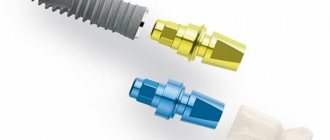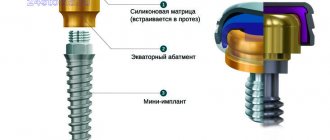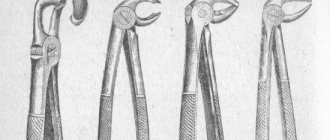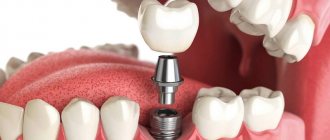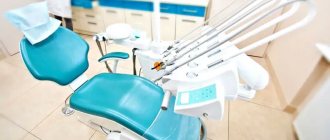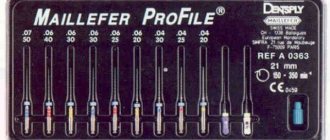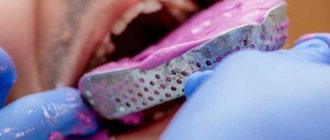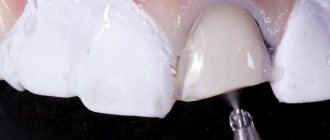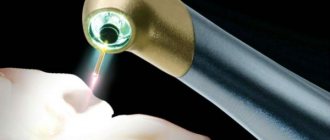Dental instruments
(outdated name -
dental instruments
) - special instruments intended for clinical examination and treatment of diseases of the oral cavity and teeth, used in therapeutic, surgical and orthopedic dentistry, as well as for dental work. Dental instruments are used in conjunction with dental equipment (see Drill, Dental equipment, Dental unit, Dental chair). Instruments for dental prosthetics have been used since ancient times (see Dentures). Greco-Roman doctors in the 4th century. BC. Special forceps were used to remove teeth; in the 11th century. n. e. The Arab doctor Abul-Qasim already had a set of forceps for removing teeth. In the 16th century French surgeon A. Pare used a set of forceps, an elevator, hooks and levers to remove teeth and tooth roots, and used various scrapers to clean carious cavities in teeth and other tools. In 1820, M. Delabarre proposed a hand drill and drills (burs) for preparing cavities in teeth for fillings. English the doctor J. Tomes in 1840 designed forceps for tooth extraction, taking into account the anatomical shapes of the teeth. The introduction of electric drills into practice contributed to the development of dental instruments in its modern sense.
In our country, mass production of dental instruments began after the Great October Socialist Revolution and currently fully meets the healthcare needs for dental instruments.
Dental instruments include instruments for general purpose, for surgical dentistry, for therapeutic dentistry and for dental work.
General purpose instruments include instruments for wedges, examinations of the oral cavity and teeth - stomatol. mirror with detachable handle, curved No. 1, bayonet-shaped No. 2 and sickle-shaped No. 3 stomatol. probes, curved stomatol. tweezers (see Tweezers). They are widely used in examining patients, during therapeutic, surgical and orthopedic manipulations on teeth, cellular processes, hard and soft palate, tongue, etc.
The industry of the USSR produces St. 300 standard sizes of burs for the preparation of hard dental tissues in the treatment of caries and dental prosthetics, as well as other core dentistry. tools. There are three main types of burs: steel, designed for drilling at speeds up to 10,000 rpm; carbide (tungsten carbide) and diamond - up to 30,000 rpm; burs for turbine drills - up to 300,000 rpm. Steel burs are designed for processing tooth dentin and drilling out its hard tissues affected by caries; carbide - for processing tooth dentin, metal and alloys; diamond burs, as well as diamond stomatol. heads - for processing tooth enamel, turning porcelain and ceramics.
Rice. 1. Rod dental instruments: 1-13 - burs (1 - spherical, 2 - shaped straight cylindrical with double thread, 3 - straight conical with single thread, 4 - truncated conical with double thread, 5 - reverse conical with single thread, 6 - wheel-shaped, 7 and 8 — cylindrical finishers, 9 — conical finisher, 10 — spherical grooved finisher, 11 — flame-shaped grooved finisher, 12 — spherical polisher, 13 — flame-shaped polisher); 14 - 17 - cutters (14 - oval, 15 - conical with double cutting, 16 - cylindrical with double cutting, 17 - conical with single cutting); 18-21 - tools for grinding teeth (18 - wheel-shaped, 19 - reverse-cone-shaped, 20 - cylindrical, 21 - disc-shaped).
Burs consist of a rod for fixing it in the handpiece of the drill and a head with a thread. By length, burs are distinguished for a straight handpiece - length 44 mm, for an angle handpiece - length 17, 22, 27 mm and for a turbine handpiece - length 20 mm. Based on the type of working part (head shape), there are (Fig. 1) spherical, cylindrical, conical and reverse conical, wheel-shaped, disk and flame-shaped burs; According to the diameter of the working part, they are divided by numbers - from small No. 1 (1 mm) to No. 11 (2.5 mm). According to the nature of the cutting edge, burs can be figured - with single or double cutting, finishers - with a continuous cutting edge, polishers - without cutting, grooved and stepped burs - with a cutting edge at the end. Typically, burs for contra-angle handpieces are supplied in sets of 175 pieces, and for straight handpieces - in sets of 125 pieces. For denture work, stomatol is mainly used. cutters (see Fig. 1) with large longitudinal edges on heads of various shapes (cylindrical, conical, oval with single or double cutting). For grinding teeth, rotating carborundum tools are used (see Fig. 1): wheel-shaped, reverse-cone-shaped, cylindrical and disc-shaped. In orthopedic dentistry (processing of steel, plastic and porcelain teeth and crowns) shaped diamond heads of various shapes are used (disc, wheel-shaped, conical, truncated and rounded, reverse-conical, flame-shaped, cylindrical, spherical, etc.), as well as flat and disc-shaped dental circles . with one- and two-sided diamond coating, dia. 12, 16, 18, 20 mm.
Stomatols are designed to transmit rotational motion to burs, heads, circles, cutters and other rod tools from a drill, pneumatic micromotor or other source of rotation. tips, cords, flexible and rigid hoses, including flexible hoses with a multiplier, which allows you to increase the rotation speed of the bur and other tools by 2 times, while ensuring longer performance of the hose rotation elements.
There are two types of dental handpieces: straight and angled.
Rice. 2. Dental handpieces: 1 - straight NL-10; 2 — straight NP-30A, 3 — angled NU-10; 4 - corner NU-30.
Straight handpieces NPB-10, NP-10A and angled handpieces NUB-10, NU-10 without bearings are designed for rotation at a speed of no more than 6000-10,000 rpm; high-speed straight tips NP-30A and angled NU-30 on bearings - for rotation up to 30,000 rpm (Fig. 2).
Turbine handpieces NST-300-2, NT-100, handpieces for sleeveless drills at 40,000 rpm, for micromotors with different gear ratios, dental equipment, etc. are also manufactured.
Rice. 3. Set of instruments for endodontics: a - general view of the small (left) and large (right) sets; b - working part of the tools (1 - depth gauge, 2 - pulp extractor, 3 - root auger, 4 - root rasp, 5 - drill, 6 - reamer, 7 - channel filler, 8 - plugger; in the circle - magnified 10 times).
Dental treatment tools
To carry out such complex operations, special equipment is used:
- The plugger is ordinary. A tool designed for applying amalgam.
- Plugger for restoration. This tool is used when modeling old amalgam.
- Auxiliary equipment. This category includes all kinds of tools to help with work: spatulas, clamps, suctions, matrices, verifiers, endo files, rimmers, spreaders, pluggers, channel fillers.
- Miller needle. Diagnostic tool for examining the patency of the root canal.
Hardening and heat hardening
To achieve the best properties of carbon and stainless steel, they are subjected to two types of heat treatments: hardening and hardening. Heat treatment gives the alloy hardness, but at the same time makes it brittle, especially with a high carbon content. Thermal hardening reduces stress in the metal and increases its strength. These properties are optimized by manufacturers. Heat of hand-held cutting tools during use can destroy the original properties of the alloys from which they are made and render the tools unusable. Firing over a flame or improper sterilization can easily render a good instrument unusable.
Instruments for prosthetics
To perform high-quality prosthetics, you need the best equipment. The following tools are included in this category:
- Cutting instruments for preparation (mechanical). Used when working with hard tissues;
- Tools for modeling (dental). Used in the processing of orthopedic devices;
- Impression trays. Materials for taking an impression of the entire jaw or its individual rows;
- Dismantling tool. Necessary for removing old crowns;
- Micrometer. Designed to determine crown thickness;
- Auxiliary equipment. Tools for mixing the solution when installing crowns;
Instrumentation for therapeutic dentistry
Instrumentation for therapeutic dentistry includes large, small and medium sets of instruments for endodontics, designed for cleaning, expansion, medicinal treatment and filling of tooth cavities and canals (Fig. 3). The kits include depth gauges of different sizes, pulp extractors, root drills, root rasps, drills, reamers, canal fillers, pluggers, a collet handle (allows you to adjust the length of the tool according to the depth of the tooth canal and ensures processing and filling the canal without damaging the apical periodontium), as well as a holder , key, etc. To expand and pass the canal with curved tooth roots, an endodontic tip NE-3-02 is used, powered by a drill, making a smooth turn, it bends 90° to the right and left, which allows the instrument to pass along the curvature of the tooth canal without perforating the root walls.
A set of tools for filling teeth consists of various shapes of excavators with sharp spoons for removing softened dentin, food debris, filling material and removing dental plaque from the carious cavity; button and cap pluggers for introducing amalgam and various shapes of smoothers for introducing and compacting medicines and filling material into the treated carious cavity; a metal spatula for preparing drugs and filling materials for use, as well as a plastic spatula, which is used in cases where drugs can react with metal or when filling materials can change color due to contact with metals. Finishers and polishers are used to polish fillings (see Fig. 1). Other auxiliary tools are also intended for filling teeth: matrices, matrix holders, separators, silver and polymer pins for filling canals, etc. (see Filling teeth).
A set of instruments for removing dental plaque consists of various hooks and curettes, which are used for scraping out affected bone tissue and granulations from pathological periodontal pockets during periodontal disease (see) and from sockets after tooth extraction. The working part of instruments for removing subgingival dental plaque is made of hard alloys.
In therapeutic dentistry, manual and machine drills for straight and angular handpieces (each of five types), root needles and other instruments are also used.
Tools for correcting bite
An orthodontist's instrumentation is very different from previous types of equipment. This specialist’s office should have the following tools:
- Equipment for cutting overgrown tissue. Used to free poorly erupted teeth. As a rule, they are applicable in pediatric dentistry, but there are cases when they cannot be avoided in case of pathology of teething in adults;
- Distal and ligature cutters. Used when shortening the distal arch and cutting the metal ligature;
- Dismantling pliers. Used to remove crowns and braces;
- Reverse grip tweezers. A tool without which installing locks for braces is simply impossible;
- Positioner. Tool for adjusting and installing braces;
- Auxiliary equipment. This group includes Smach, Matthew and Hilgers clamp forceps. They are designed to grip, twist the ligature and apply bends to the ligature arch;
Instrumentation for surgical dentistry
Instrumentation for surgical dentistry is represented by forceps for tooth extraction, elevators and other instruments, as well as general-purpose surgical instruments.
Rice. 4. Dental forceps: 1 - for removing the upper left large molars; 2 - for removing the lower large molars; 3 - for removing lower canines and small molars; 4 - bayonet-shaped for removing the roots of the upper teeth; 5 - for removing the upper molars; 6 - bayonet-shaped (bayonet) for removing upper wisdom teeth; 7 - for removing the upper incisors and canines.
Tooth extraction forceps consist of a working part (cheeks), handles (branches) and a lock. Tooth extraction forceps for adults and children differ in size. In forceps for the teeth of the upper jaw, the axes of the cheeks and handles coincide or are parallel (Fig. 4); forceps for teeth of the lower jaw are beak-shaped, with a bend along the edge and along the plane at an angle from 90 to 110°, depending on which teeth need to be removed (front or lateral). The shape of the cheeks of the forceps is determined by the anatomical structure of the crowns of the teeth, for which they are intended for removal: the cheeks of the forceps for removing teeth with an intact crown do not contact each other and have a concave surface for a reliable grip of the tooth crown; The cheeks of the forceps for removing teeth with severely damaged crowns, roots and incisors converge. S-shaped forceps are designed for removing upper molars; They are made for the right and left sides and are distinguished by the fact that on the outer cheek they have a spike for gripping the recess between the cheek roots. The doctor uses the forceps as a lever, applying considerable effort, which is why they are made massive, made of durable steel; There are notches on the outer surface of the handles so that the forceps do not slip in the dentist’s hand.
Rice. 5. Dental elevators: 1 - T-shaped; 2 - straight; 3 - right; 4 - left.
Elevators for removing teeth and roots are used in the same way as levers when greater force is required. They consist of a working part (its dimensions can be different), a connecting neck and a handle. Their total length is from 141 to 159 mm (Fig. 5). The handles are hollow, faceted, pear-shaped for secure fixation in the hands. Straight elevators are used to remove upper teeth and roots, and curved elevators are used to remove lower teeth and roots; They are also made in two types - with a working surface for the left or right side. A T-shaped elevator with a solid handle and a bayonet-shaped working part is sometimes used to remove third molars, but great care must be taken.
Instruments for surgical dentistry are usually included in sets, for example, a 14-piece set of dental forceps and elevators, a 27-piece set of instruments for removing teeth in children, containing dental forceps, tweezers, raspators, and curettage spoons. Sets of instruments for certain types of plastic surgeries are also produced.
General surgical scalpels and scissors are used depending on the anatomical area where the operation is performed and the nature of the surgical intervention. Ophthalmic scalpels and scissors are often used (see Surgical knives). To bite off the sharp edges of cellular processes, interradicular septa and jaws, bone dental nippers are used, the thin elongated cheeks of the working part of which end with sharp edges.
Features of dental equipment from Levant
Why you should order equipment for dental procedures on the Levanta website:
- All tools are made from high quality materials. Our dental products are certified;
- The instruments comply with modern international standards;
- A wide range of;
- Affordable prices, wholesale and retail trade;
- Delivery of goods to any region of Russia;
Levanta specialists will select suitable medical equipment for your clinics and private offices. Absolutely all products of the dental group are covered by a guarantee.
Dental instruments for dental treatment
In their practice, dentists use various dental instruments to examine the patient’s oral cavity and treat damaged teeth. Each instrument has its own purpose and is used for the doctor’s most painless manipulations with damaged teeth and gums.
Inspection Instruments
The dentist, after listening to the complaints of the patient who contacted him, must carry out an examination, which consists of a thorough examination of the oral cavity and teeth. A professional dental examination is carried out using diagnostic tools:
— diagnostic mirror – is a round mirror on a long handle and is used to examine areas in the patient’s mouth that are difficult to access and invisible during visual inspection; - probe - looks like a hook with a long handle and is used to determine defects and dental caries, the depth of the carious cavity, its density and sensitivity, as well as the presence of tartar; - tweezers - used by the doctor to determine how loose the tooth is, as well as to place or remove a cotton swab.
Tools for treatment
Treatment of a carious cavity discovered during examination by a dentist consists of several complex stages:
- opening of the cavity; — cleansing and removal of damaged tooth tissues; — filling the cleaned cavity.
Special dental instruments are also used to treat caries:
- dental excavator - is an elongated holder with curved thin ends on both sides, used to remove temporary fillings, food debris and soft damaged tooth tissues; the excavator also removes plaque and deposits on the teeth; - smoothers and spatulas - they are a long holder with spatulas on both sides; they are used to mix filling materials and place them in the open cavity of the tooth; - bur - used to open the cavity and clean it from tissues affected by caries; there are several types of burs for the convenience of cleaning cavities of different shapes, sizes and depths; - disc - used after closing the cavity with a filling to smooth its surface and sharp edges that could remain after treatment with boron; - polisher - the purpose of polishers is the same as that of discs, but they have a different shape. Using the listed tools, the dentist will conduct a preventive and diagnostic examination and save the patient from caries and other dental defects.
